Day 2 of a two day weekend tour today. We were forecast some rain this afternoon, but thankfully it wasn’t as bad as forecast and we pretty much got a full day’s birding in. Once again we met up in Wells, but this time we were heading west.
First of all, we headed out to the local gull colony. There were lots of Black-headed Gulls, noisy as ever. On the edge of the melee were a few Common Gulls, not so common in the summer in this part of the world. They were looking particularly smart, with pure white rounded head, offsetting the dark eye, and a bright yellow bill. In the middle of the colony, we could pick out a few Mediterranean Gulls. Unlike the Black-headed Gulls, which actually have a chocolate brown hood, the Mediterranean Gulls have a jet black hood which extends further down the nape – like they have pulled down their balaclavas properly! Their darker black heads really stood out amongst the tussocks of grass where the gulls were nesting. We could also hear their distinctive calls as they flew round overhead and see their distinctive white wing tips in flight.
 Common Terns – on the stones on the edge of the gull colony
Common Terns – on the stones on the edge of the gull colony
It was not just the gulls we had come for, but the terns as well. As soon as we arrived, we could see several Common Terns fishing in the channel and standing on the stones on the edge of the gulls. We got them in the scope, and could see their black-tipped orange/red bills. Further over, we could see another tern on the shingle, but this one had a shorter, darker blood-red bill – an Arctic Tern. A second Arctic Tern was fishing, hovering out over the water beyond. We could see its longer tail and pale wing tips with a very neat narrow black line on the trailing edge of the outer wing underside. With several Common Terns in the air as well, we got a good chance to study the differences.
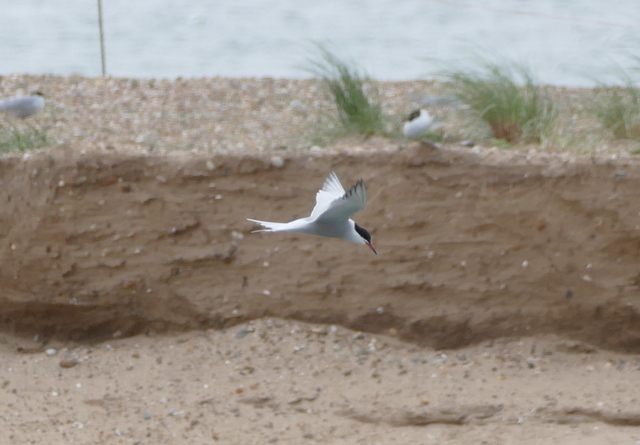 Common Tern – feeding over the channel in front of the colony
Common Tern – feeding over the channel in front of the colony
There were other terns as well. Down on the beach below several Little Terns had gathered. They would also periodically fly round fishing in front of us. A Sandwich Tern also patrolled up the channel, and with Sandwich and Little Terns together at one point, we could really see the size difference. This is a great place to watch terns, with four species in view at the same time! Great stuff.
Holkham was out next port of call. Walking west behind the pines, there were lots of warblers singing – Blackcaps, Whitethroats, Chiffchaffs and Willow Warblers, Cetti’s, Sedge and Reed Warblers – a good opportunity to try to recognise the different songs. There were the usual groups of tits, particularly Long-tailed Tits calling from the trees, and a Coal Tit came out of the pines and performed nicely for the crowd. Some quiet contact calls alerted us to the presence of a Treecreeper and we got a lovely view of it working its way methodically up a pine. There were yet more Treecreepers, tits and Goldcrests singing from the trees unseen.
By Meals House came the surprise of the morning. We had just stopped to listen to some warblers singing when one of the group pointed down along a little grassy path and asked ‘what’s that?’. Creeping through the grass was a pipit, and as it turned we could see that it was a Tree Pipit. It walked towards us, then saw us and turned and crept stealthily into the longer grass out of view, pumping its tail quietly. Tree Pipits here are generally migrants and this bird had probably dropped in to feed here on its way north. A cracking performance, rather than the more usual view of migrants calling as they pass overhead.
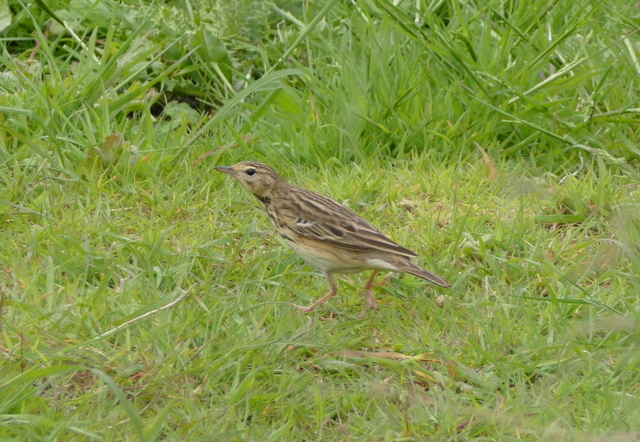 Tree Pipit – creeping through the grass by Meals House today
Tree Pipit – creeping through the grass by Meals House today
We called in at the Joe Jordan hide, as usual. There was plenty of activity around the cormorant and heron colony, with a couple of Spoonbills coming in or going out towards the saltmarsh at Wells or Burnham Overy to feed. Even more Spoonbills were just flying out of the trees, circling round and landing back again out of view. From the path later we got one in the scope in the trees, but in typical Spoonbill fashion it was fast asleep!
There was quite a bit of Marsh Harrier activity as well. One smart grey-winged male came low in front of the hide, and continued west pursued by Lapwings and Jackdaws. The pair of Grey Partridge was still present, feeding on the grass below the hide. And we marvelled at the way the song of a couple of Sedge Warblers carried to us from a long way across the grazing marshes – two males on opposite sides of the hide clearly trying to out-sing each other.
With some Scandianvian migrants arriving elsewhere along the coast this morning, and encouraged by our own earlier Tree Pipit, we thought it was worth a look in the dunes. However, the bushes were rather quiet today. We flushed a family of Mistle Thrushes which flew up into the trees and watched a pair of Kestrels hanging in the air above the dunes. From up on the top of the dunes, we could see a raft of several hundred Common Scoter still distantly out on the sea.
There were little groups of Swallows still moving west today, on their way somewhere. Amongst them, we picked out a couple of House Martins and a single Sand Martin as well. The number of Wheatears in the dunes has tailed off now, but we eventually found a very smart male Greenland Wheatear in one of their favoured areas. We got it in the scope and admired its richly-coloured burnt orange throat and upper breast.
 Greenland Wheatear – a male in the dunes still today
Greenland Wheatear – a male in the dunes still today
It was forecast to rain today and, on cue, we could see the clouds starting to build from the west. Rather than continue on through the dunes, we headed back to the pines. We stopped briefly on the way to admire the first Marsh Orchids emerging in the dune slacks. On the walk back to the car, the rain finally caught up with us. Thankfully, it was not heavy, mostly a little drizzle, and we were not too wet by the time we got back.
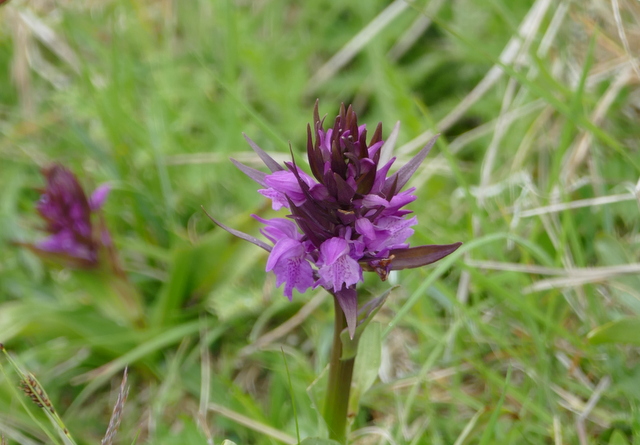 Marsh Orchid – the first few spikes are starting to appear in the dunes
Marsh Orchid – the first few spikes are starting to appear in the dunes
We headed west to Titchwell and thankfully we drove underneath the weather front and out of the rain as we did so. After lunch, we walked out onto the reserve, stopping to listen to a Song Thrush singing from the trees by the visitor centre on our way. On the reedbed pool, we found our first pair of Red-crested Pochard for the day, as well as a few Common Pochard and Tufted Duck, and a single Great Crested Grebe. It was still overcast after the rain and in the cloudy conditions there were lots of Swifts hawking for insects low over the reedbed and whooshing past us on the bank.
While we were standing there, there was a loud ‘BANG!’ as a flare appeared from over towards the village – who knows why. All the birds on the freshmarsh took to the air, and we watched a flock of Black-tailed Godwits fly over us and off towards Thornham. Whether it was the fault of the flare, or the two Sparrowhawks that flew over the freshmarsh as we got into the Island Hide, or both, but there were fewer waders than recent days by the time we got to scan the mud. We found a single Ruff with a couple of Redshank, and a few Black-tailed Godwits left behind. At least the Avocets had not been put off.
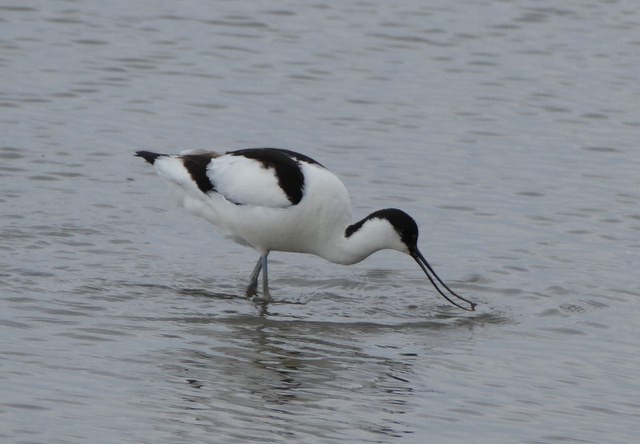 Avocet – one of the Titchwell regulars, with its catch of the day
Avocet – one of the Titchwell regulars, with its catch of the day
There were still five Little Gulls scattered around the freshmarsh, all 1st summer birds with a black ‘W’ pattern on the upperwings and sporting a varying amount of black hood, from almost full winter white head with black spot to about 3/4 complete black hood. From up on the main footpath, a small group of gulls had gathered to bathe and we got a great chance to see just how little the Little Gulls are as they stood next to the Black-headed Gulls, preening.
 Little Gull – a 1st summer bird with a partly acquired black hood
Little Gull – a 1st summer bird with a partly acquired black hood
As we arrived in the Parrinder Hide there was a bit of a commotion as one of the people already in there announced they thought they could see a Bittern on the edge of the reeds on the far side of the water. Unfortunately, there has been a rather convincing piece of brown rubbish, shaped not completely unlike a crouched Bittern, tucked into the reeds on that side for some time now. Excitement over, unfortunately.
We did manage to find a couple of Little Ringed Plovers lurking amongst the emergent vegetation on the island in front of the hide. Through the scope, we could see their golden yellow eye rings. Better still, a single Ringed Plover was nearby and at one point we had the two species side by side, which gave a great size comparison for us. A single female Pintail was the only other surprise, a rather late lingering bird as most of the Pintail which we enjoyed watching over the winter have long since departed.
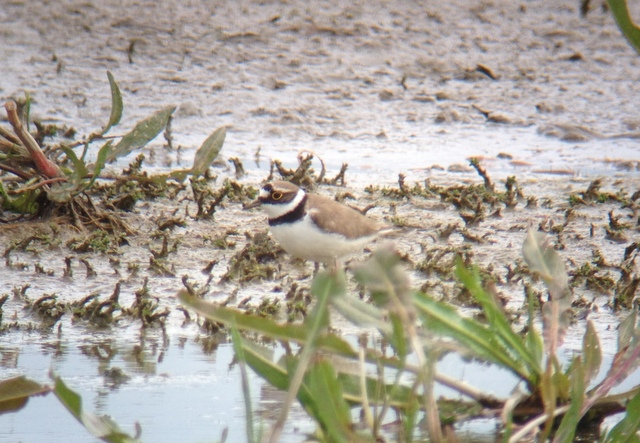 Little Ringed Plover – check out the distinctive golden yellow eye-ring
Little Ringed Plover – check out the distinctive golden yellow eye-ring
The Volunteer Marsh and Tidal Pools were both very quiet today, so we headed straight to the beach. The tide was just going out and the rocks were only just starting to emerge from the waves. As the first piece appeared, two Oystercatchers flew in to occupy it and were soon joined by three Turnstone, one coming into its smart white-faced, rusty-backed summer plumage. There was precious little space left, but a small flock of Sanderling decided to try their luck as well. Unable to land at first, they eventually found some space as the sea receded a little further. At this time of the year, with their scaly dark-patterned summer plumage, they look rather different to the silvery Sanderlings we see running around on the shore over the winter. There were also still a few Grey Plovers on the beach in various states of summer plumage. The sea was typically quite quiet, apart from a few terns passing offshore from the colony at Scolt Head.
By this stage, time was getting on so we headed back to the car park and drove up to Choseley. Remarkably, there were still five Dotterel present. It has been an amazing year for this species here, with trips of Dotterel of one size or another in one of the fields at Choseley mostly since April 13th (with only a few days when none were picked up). It took us some time to find them today. The sun had come out by that stage and there was a fresh NW wind up on the ridge. The Dotterel had settled down to sleep in the furrows and with the young sugar beet plants growing then they were even harder to find than usual. For such colourful birds, they can really disappear when they sit down! Eventually one put its head up and we were onto them. We could see them shuffling round and catch a flash of bright white supercilium as they lifted their heads.
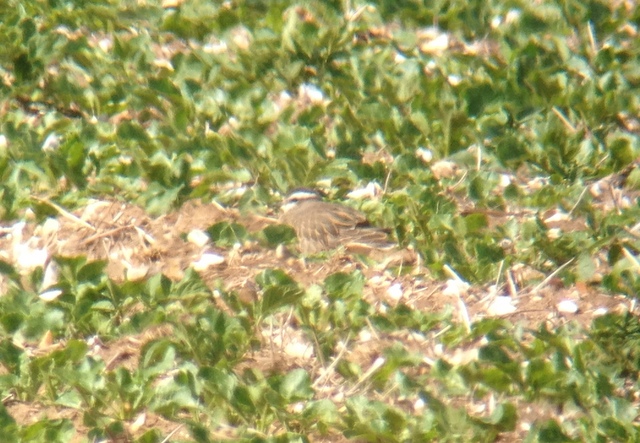 Dotterel – hiding amongst the emerging sugar beet plants
Dotterel – hiding amongst the emerging sugar beet plants
That seemed like a good way to finish, and with some of the group with long journeys ahead of them, we headed back to Wells. Once again, we had a very productive weekend with a good selection of birds to be seen.
















